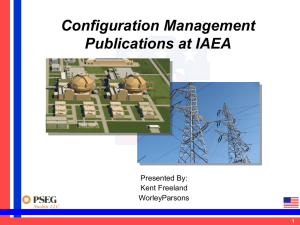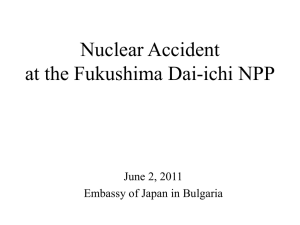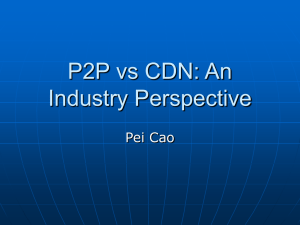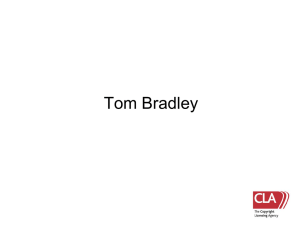Overview of Updated IAEA documents SR-65 and TECDOC-1651
advertisement
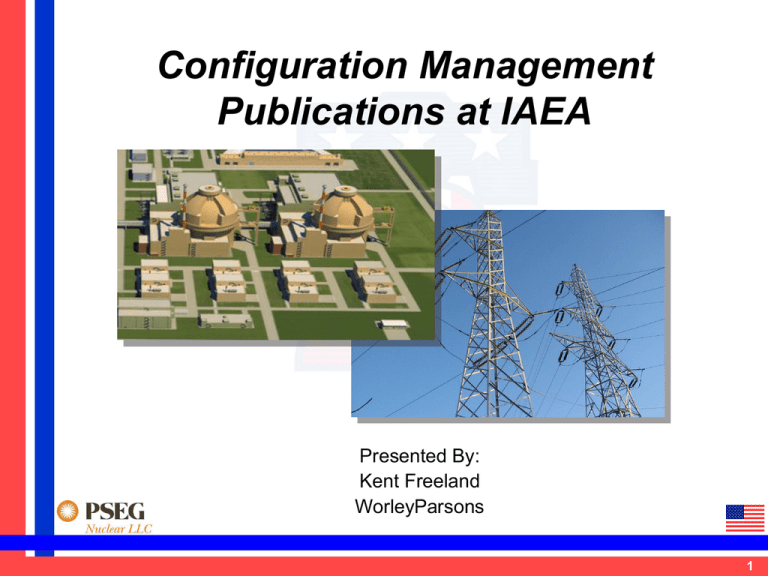
Configuration Management Publications at IAEA Presented By: Kent Freeland WorleyParsons 1 IAEA CM GUIDANCE DOCUMENTS The IAEA has been active at providing CM guidance to nuclear entities outside of the USA. In 2010 the Agency issued two new CM documents: Safety Series Report 65, “Application of Configuration Management in Nuclear Power Plants” and TECDOC-1651, “Information Technology for Nuclear Power Plant Configuration Management.” This presentation will provide an overview of these documents and establish the linkage to current USA CM guidance. NPP Version 1.0 Design Package 11-00001 NPP Version 2.0 2 IAEA and CM • The International Atomic Energy Agency (IAEA) is part of the United Nations Organizations (UNO) located in Vienna, Austria. • The Agency originally established the Configuration Management program within the Nuclear Engineering (NE) Department. The responsibility was split between NE and Nuclear Safety. • Currently, the majority of the CM activity has been transferred to the IAEA Nuclear Safety (NS) Department. • IAEA Publications have several classifications, such as Technical Documents (TECDOC) and Reports . Official IAEA publications can take anywhere from 1-3 years to develop from concept to publication. • This lifecycle can create some risk of obsolescence. • The Agency recognizes the importance of CM for NPP’s and includes CM Requirements in their new build requirements for Member States. 3 Current IAEA CM Publications • Most IAEA publications were co-authored or primarily written by CMBG members. • There are normally a number of Member State reviewers who review and comment on the draft documents • The two latest were principally written by Kent Freeland, Rick Harris and Cliff Wallen, all CMBG attendees. 4 TECDOC-1651 “Information Technology for Nuclear Power Plant Configuration Management.” 5 TECDOC-1651 “Information Technology for Nuclear Power Plant Configuration Management.” • TECDOC-1651 was largely written by Kent Freeland and Cliff Wallen, with the work split between Information Technology and Design Basis. • The document was then reviewed and edited by Kent and Cliff to cross check content, and published in March of 2010. • The document is a new concept, and does not replace any existing IAEA publication. It completes the Configuration Management trilogy of CM Requirements, Technology Impact on NPP Document Management Systems (TECDOC-1284 by Dr. Ki-Sig Kang of IAEA)) and Implementation and NPP Information Technology. • The document address NPP MRO and ERP requirements in general, with emphasis on CM and related programs. 6 TECDOC-1651 “Information Technology for Nuclear Power Plant Configuration Management.” • Title “Information Technology for Nuclear Power Plant Configuration Management” • Requested by: Nuclear Engineering Department • Sponsor: Jiri Mandula • Authors: B. Grimes, K. Freeland, C. Wallen • Supersedes/Replaces: N/A • Applies to: NPP’s during design, construction and operation • Commenced: October 2008 • Published: March 2011 • Available from: IAEA Publications website http://www-pub.iaea.org/MTCD/publications/PDF/te_1651_web.pdf 7 TECDOC-1651 “Information Technology for Nuclear Power Plant Configuration Management.” General Purpose • Describe the requirements of forming and maintaining an NPP design basis, and conducting a design basis reconstitution if necessary. • Describe and outline the requirements for NPP enterprise configuration management information technology solution to store and maintain the design basis and other NPP configuration management data. • Includes development of supporting MRO, ERP and Knowledge-based functionality for enterprise nuclear business processes and business rules. • The TECDOC includes examples of enterprise NPP CM solution architecture, functionality, interfaces and data models. • Also compares the advantages of repository- and PLM (Plant Lifecycle Management)-based solutions. 8 TECDOC-1651 “Information Technology for Nuclear Power Plant Configuration Management.” Suggested Utilization The TECDOC should be reviewed and referenced during the review of design basis programs and to assess the state of the NPP design basis library and engineering change control system. It is also recommended as a checklist for design basis review during engineering change control and modification activities. The document is recommended as a handbook for preparation of specifications, RFQ’s and purchasing bid media for development or purchases of enterprise CM, MRO and ERP software solutions The document also aids in selection of supporting applications such as engineering design and 3D CAD environments, document management applications, content management and IMS support systems and other 1st- and 2nd-tier software. 9 Safety Series Report No. 65 “Application of Configuration Management in Nuclear Power Plants” 10 Safety Series Report No. 65 “Application of Configuration Management in Nuclear Power Plants” • Originally designated as publication 1461, was largely written by Rick Harris of CMBG. • It was reviewed and edited by Kent Freeland, and published in January of 2010. • Replaced the venerable TECDOC-1335, “Configuration Management in Nuclear Power Plants”, originally published in 2003 and considered a benchmark for CM references. 11 Safety Series Report No. 65 “Application of Configuration Management in Nuclear Power Plants” Safety Series Report No. 65 Title: “Application of Configuration Management in Nuclear Power Plants” Requested by: Nuclear Safety Department Sponsor: Csila Toth Authors: R. Harris, K. Freeland Supersedes/Replaces: TECDOC-1335 Applies to: NPP’s and Nuclear Facilities during design, construction and operation Commenced: Summer 2008 Published: January 2011 Available from: IAEA Publications website http://www-pub.iaea.org/MTCD/publications/PDF/Pub1461_web.pdf 12 Safety Series Report No. 65 “Application of Configuration Management in Nuclear Power Plants” General Purpose Describe the requirements and business processes in NPP’s to develop and implement a comprehensive configuration management program, processes and procedures. Includes premise, requirements, processes and resources to establish and maintain a CM program for NPP’s. Replaces TECDOC-1335, “Configuration Management for Nuclear Power Plants”, published in 2003. 13 Safety Series Report No. 65 “Application of Configuration Management in Nuclear Power Plants” Suggested Utilization This Safety Series Report was published in the new IAEA Report Format, in compliance with the new four-tier document hierarchy structure. This document should be reviewed and referenced during development and when writing process plans and procedures for NPP CM implementation, review, STAR Assessment or Audit. May also be utilized to assess contractor and vendor/supplier CM programs and related taxonomies. 14 Overview 15 Elements for CM Review and Assessment of overall NPP Configuration management and IMS needs Review and Plan for Design and Construction Requirements, or Legacy NPP Operation Review of current IT architecture and Nuclear Management Systems infrastructure Nuclear Business Processes Review, with emphasis on: – Master Equipment List (MEL) Registration and Taxonomy – Document and Records Management (RM/DC) facilities – Engineering Design Control and Design Basis Management – plus Materials and Work Management interfaces to support CM. Propose CM and IMS Methodology to Implement Full-Scope Templatebased CM and IMS systems Design for End-to-End CM Data Flow – Creation, Review/Verification, Publication Custom-Match and Employ a Graded Approach to Adjust Level of Detail to NPP Technology and Safety/Risk function of components. Develop Custom Baseline CM Process and Procedures for NPP Assist in selection or development of modern, metadata-based Departmental and Enterprise IT solutions to fit NPP IT architecture and needs Assist in development of CM Information Technology, Data and Process Management processes. Support and Integrate CM with existing or planned NPP Nuclear Knowledge Management (NKM) and Integrated Management System (IMS) programs Processes Processes and and Templates Templates using using IAEA IAEA GSGS- RR- 33 ThreeTier Data Management Architecture Three- Tier Data Management Architecture Integrate Integrate with with IMS IMS program program to to support support CM CM Plant Plant Lifecycle Lifecycle Management Management (PLM) (PLM) Principals Principals Integrated Integrated Management Management System System (IMS) (IMS) –– Proactive Proactive Framework Framework for for FullFull- Scope Scope ISO ISO 9001/ 9001/ 14001Quality 14001Quality Management Systems endorsed by IAEA, Management Systems endorsed by IAEA, EPRI EPRI and and INPO INPO 16 Design Requirements, Design Basis – and Design Responsibility The NPP Design is developed, recorded and managed from the first day of NPP design. Design Requirements come from NSSS Vendor, State Regulator, NGO’s and other sources. The ability to preserve, manage and apply these design requirements and form a design basis for the NPP is the cornerstone of NPP Safety. As the plant is changed, the recorded design basis must change also to preserve the overall design and establish or adjust operating margins. Without a Design Basis, Everybody forgets “Why was this change made? Every Design Change has a documented package showing what was changed and why. NPPVersion Version1.0 1.0 NPP Design Package 11-00001 Design Package 11-00001 NPPVersion Version2.0 2.0 NPP 17 Elements of Design Requirements NPP Design Basis History – what was changed in the NPP, and how it will behave now Margin Analysis and Management – The distance between normal operation and failure of a component Technical Specifications (TS) – Parameters and conditions under which safe NPP operation may continue, even at a reduced level Warehouse, Handling, Issue & Return Beyond Design Events – Ensuring consideration of mitigation for those NPP events considered beyond anticipated normal design basis accidents. Safe Shutdown – the ability to stop the plant and secure the reactor in a way to not present any harm to the public. Design DesignVerification/Walkdown Verification/Walkdown PLM Roles and Controls for Procurement and Materials Qualification Component ComponentQualification/QA Qualification/QA Materials Receipt Procurement Manufacturer/Supplier Manufacturer/SupplierQAQA Plant Design Basis Engineering Design Change Physical Plant Equipment Plant Documentation Document Control and Quality Records Master Equipment List (MEL) Equipment Documents & Records Radiation Protection Material & Inventory Engineering Change Bill of Material DATA HUB Project & Financials Purchasing All of these factors affect the ability to keep the NPP safe during a Design Basis Accident. Engineering Design Change QCQCInspection Inspection Limiting Conditions of Operation (LCO) – Plant events that may call a Technical Specification into use Design Basis Events and Accidents – credible postulated events during plant life for which the NPP and its safety systems are designed to ensure plant continued safe operation or safe shutdown. Fitted to Plant as Equipment MR MRIssue/Return Issue/ReturnVerification Verification Action Tracking Work Management Employee & Timekeeping 18 Elements for CM - Basics about Classic CM and Nuclear Design Basis Management CM is the Preservation, Verification and Recording of NPP Plant Design Basis CM is supported by NPP IMS, NKM, PLM and MRO NPP Programs and Processes, and CM should be integrated as a part of the IMS Program. Audits QA Program & Plan NCR’s Document Reviews Commitment Tracking Process Review and Templates QA Integrated Integrated Management Management Systems Systemsjoin join the theCM CMand andQA QA functions functionsinto intoaa complete, complete, reliable reliableNPP NPP quality qualitysystem system Programmatic Integrated Management System Practical Equipment Design Documents/DBD Design Changes Changes Documents/DBD Work Work Management Management Materials Materials && Parts Parts The Configuration Management CM Infrastructure – Management Processes, Procedures, Technology Solutions for (1) Data Creation & Capture, (2) Review and Content Management, (3) Production MRO The TheThree-Tier Three-TierModel Modelfor forManagement Management ofofCritical CriticalCM CMData Data CM and IMS Programs for New Builds Data Generation A “Tier”-based deployment plan for Enterprise NPP Solution for Design, Construction and Operation Phases of plant development CADD, construction data, Intergraph PDS, simulation, CAE, engineering data sheets, Action Items, CARs, project management, etc. PROCESS CONTROL or Operating NPP’s have most characteristics in common, with special considerations for EPC and supplier relationships Concept & Design Data Concept & Design Data Data is as PLM Design & Construction Design & Construction complete as possible Data Review/Approval Document Manager (EDMS), Engineering Workflow & Routing (eProcess EDR), Action Tracking. PLM Operation Operation Enterprise CM Data is validated as much as possible MEL, DCM, ECC, Materials, Work Management, etc. 19 Preserving the Design Basis from Design to Documents Design Basis Master Equipment List Vendor and Licensing Documents I N P U Understanding the Design - CM will facilitate to prevent losses of regulator and public faith and achieve Operational Excellence goals, and ultimately, avoid expense and risk of shutdown and/or performing a costly design basis reconstitution. Design Basis Documents T S Creation Creation of of aa Plant Plant Design Design Basis Basis Plant Design Basis Design Requirements from Plant Vendors and Constructor, as well as Equipment Requirements and Determinants, such as Operating Factors, LCO’s, Technical Specifications, etc. determine a Design Basis … Design and Work Order Order Execution for Installation Equipment and Engineering Design Understanding the Equipment – The Engineering Design Process will specify and place the proper equipment for the Design Basis needed – for Safety and Operation The Work Management Process Records and Documents the Installation, Testing and Commissioning of the Design Change solution in the Physical Plant… Startup Tests and Commissioning To Design Basis Documents Work Order Closeout Design Basis Update To Design Basis Documents Controlled Documents Engineering Design Change Design Documents Component Procurement Specifications Assure Safety by Preventing Mismatches in Plant Design Basis, Documents and Equipment Content Resulting in Shutdowns, Accidents, Exposure Prevent Losses of Regulator and Public Faith Establish and Maintain Responsible Engineering Practices Achieve Operational Excellence Goals Step Increase in Efficiency, by Reduction of Shutdowns, Maintenance Rework, and Materials Spend Smooth and Refine NPP MRO and Nuclear Business Processes Parts Substitutions Minor Design Changes Quality Records Physical Plant Design Basis Document Creation/Revision Design Basis Reconstitution The Engineering Design Change Process utilizes the Design Basis as Input. It may also modify the Design Basis, which must be documented in the Design Criteria. Affected Design Documents are then created and/or updated, and Procurement Requirements for parts are determined … Understanding the Documents Nuclear Power Plants, in particular, have CM requirements that go beyond commercial or efficiency considerations. Nuclear Power deals with the requirement for 100% safe operation and positive design control, as represented in Controlled Documents. Avoid Expense and Risk of Shutdown and/or Design Basis Reconstitution 20 Information Technology-based CM and IMS CREATE CREATE REVIEW REVIEW&&APPROVE APPROVE PUBLISH PUBLISH Archimed Knowledge Portal EPC & Vendor Source Data Engineering/3D Engineering/3D Design Design Review Review Construction Construction Materials Materials Qualification Qualification Procurement Procurement Turnover Turnover Meta Meta Data Data and and XML XML Data Data Dictionaries Dictionaries MRO MRO Archimed Archimed GSR3 GSR3 Engineering Engineering Content Content Management Management PLM eProcess eProcess Correspondence Correspondence Mgr Mgr Parent Corporate ERP/Accounting PLM eDMS eDMS Document Document Manager Manager Siemens Siemens PLM PLM TeamCenter TeamCenter Nuclear Nuclear PLM SAP SAP R3 R3 ERP ERP eDR eDR Engineering Engineering Design Design Review Review SmartPlant SmartPlant 3D 3D CADD CADD Design Design Data Data and and Business Business Models Models SmartPlant SmartPlant Foundation Foundation Example CM, IMS and MRO/ERP design for Belene NPP using Archimed GSR3, Intergraph and Siemens TeamCenter Nuclear IT solutions 3D 3D Render Render Three-Tier CM and Design Management technology systems for enterprise Configuration Management in Nuclear Power plants is implemented at the Belene NPP project. 21 Design Basis Retention & Configuration Management Safety Analysis Report (SAR) and updates Equipment and Component Procurement Specifications Technical Specifications and Operating Parameters Equipment and Operating Plant Programs, such as Seismic and Environmental Qualification, Safe Shutdown, Fire Safety, ASME ISI, ATWAS, Loss of Offsite Power, etc. Materials Management Catalog ID Q-Level Industry and NGO Standards (IAEA, WANO, EUR, WENRA) Component Manufacture Certificates and Passports Materials and Parts Qualification These documents are an integral part of the NPP licensing and design process, and form the basis for operating license compliance NSSS Vendor Design Requirements (WCAP) and Design Technical Specifications 5 Master Equipment List Equipment ID 1 Engineering Change Control NSSS, Vendor and Manufacturer Correspondence Work Order Number Modification Number Design Basis Drawings and Documents Installation Work Orders and Field Design Changes Work Management Document Control 3 4 Document Number Sheet Revision 2 22 Nuclear Knowledge Management Capture of latent and potentially lost knowledge among nuclear operators Daily NPP Operations: Information, Facts, Design Data and Operating Experience acquired, reviewed, corrected and verified as part of normal NPP operation, then recorded and documented to maintain plant configuration Latent Knowledge: Information, Experience and Knowledge accumulated over time by personnel, which may or may not have been formally recorded or documented. CM and MRO Data from Daily NPP Operations and Work NPP Processes, Procedures and Business Rules Known NPP Experience Repositories (OE, ISEG Reports, System Engineering, etc.) Configuration Management and MRO Systems Knowledge Coincidental to Daily NPP Work Nuclear Business Systems Maintenance Resource Optimization (MRO) Information/Data “PUSH” Information/Data “PUSH” Configuration Management (CM) MRO/ERP Systems (Passport/Asset Suite, MAXIMO, TeamCenter) Enterprise Resource Management (ERP) Plant Lifecycle & IT Communication Bus NPP Nuclear Knowledge Management Systems NKM Repository and Publication Tools Undocumented Facts Information/Data “PUSH” Information/Data “PUSH” Experience NKM Program Media: Interviews, STAR Audits, Outage Debriefs, etc. Vendor and Contractor Technical, Design and Process Information EXCELL/Informatics Lessons Learned Knowledge Base Search Engines NKM Capture Portal (INTUIT, EXCELL, Informatics) Operations Data Work Management, Alignment, Process Control Commissioning Data Materials Catalog Procurement Scheduling Book of Knowledge Data Repository CADD / PDS Content Management & Design Review Control Construction & Labor Data Correspondence Process Control Engineering Design Data Design Basis Library Master Equipment List Document Document Management Management Engineering Analysis & Codes Circuit & Raceway Piping Analysis Valve Lists Legacy & Baseline Data Prevent “Loss of Memory” and Loss of Valuable NPP Operating Experience 23 NPP Integrated Management Systems (IMS) Template-based, unified quality management and development of consistent processes and procedures. Follow IAEA GS-R-3 Management System Principles NPP software and systems are developed to support GS-R-3 requirements and best practices for processes. Consistent implementation of processes and procedures ensures that NPP Operation and Design Basis. NPP MRO, CM and Business Software and Technology choices are very critical for IMS to be properly deployed Best utilized with Plant Lifecycle Management (PLM)-based information system technology solutions. IMS Integrated Management Systems and GS-R-3 concepts are utilized by Belene for NPP Management Systems development and implementation. Asset Management Risk Management Business Planning Performance Improvement Change Management Configuration Management Communications Requirements and Grading Environmental Management Industrial Safety Information Management Security Regulatory Compliance Human Resources Training and Qualification Design Basis Technical & Reactor Governance Document Control Records Management Emergency Preparedness Project Management Knowledge Capture and Portals Skills and Knowledge Mapping Enterprise Resource Planning Work Management Engineering Design Work Management Change and MEL Operations, Tagout Work Management and Configuration Warehouse, Work Management Issue/Return and QC Receipt Preventive Work Management & Recurring Maintenance Work Management Qualification Programs Nuclear Fuel Outage Management Safety and MSDS Purchasing Internal/Self Assessment External Assessment Audits Operational Experience Asset Condition & Performance (CAP) Financial Controls M anagem ent S ys t e m s & Pr ogr am s Res our ce and K n o w le d g e M anagem ent P r o d u c t io n a n d O p e r a t io n s Catalog and Materials Work Management Management NPP Plant Process Matrix NPP Plant Process Matrix A s s es s m ent s and KPI Control Health Physics/Radiation Protection Work Procurement Management Engineering 24 New NPP Construction and Design Basis Management REQUIREMENTS AND REQUIREMENTS AND SPECIFICATIONS SPECIFICATIONS Development and preservation of the Design Basis begins on the first day of the design process. Information Technology and a broad, DESIGN DESIGN PLM-based Network Infrastructure are needed to communicate design and equipment manufacture requirements between construction parties (EPC, Owner’s Engineer, Owner-Operator and Suppliers). Design Decisions, Review and Comments, Component NonConformances and Field Design Changes must be communicated immediately to the Project via a Configuration Management (CM) and MRO infrastructure. Use of 3D Modeling and Design CONSTRUCTION CONSTRUCTION Platforms, Integrated with CM and Design Information Technology to create a seamless design environment over a PLM backbone. 25 Applicability to USA Configuration Management Programs • Both documents authored by nuclear professionals involved in current USA programs and familiar with leading commercial nuclear software solutions • Enhance understanding of current trends in nuclear new build licensing and CM Requirements. • Documents are written in context of most recent developments in overall nuclear power betterment infrastructure, including Integrated Management Systems (IMS), Knowledge Management (KM) as well as CM. • Recognition of new technology solutions which change the landscape of implementing CM programs for new builds • Closer integration of Architect/Engineers, EPC’s and suppliers in the new build CM requirements. • Improved understanding of contractual requirements for new build NPP’s in the areas of IT and CM. 26 Applicability to USA Configuration Management Programs • EPRI Advanced Nuclear Technology Program and Standard CM Models for NNPP’s • Process-Oriented Knowledge Management Programs and CoP’s • New Requirements for Enterprise NPP Technology Solutions from Owner/Operators and new-build EPC’s 27 Questions? Thank you! 28

